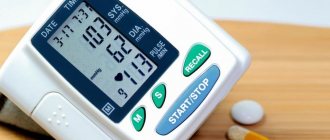The average normal blood pressure is not ideal for everyone. Deviations from the notorious 120/80 can be either upward or downward. But if high blood pressure is considered clearly dangerous to health, hypotension does not always signal a threat. For some people it is familiar and is a variant of the norm. However, extremely low numbers are a reason to be wary. Especially if accompanied by dizziness, weakness and lightheadedness.
What is arterial hypertension
Arterial hypertension is the most common disease of the cardiovascular system, associated with a persistent increase in systolic pressure to 140 or higher mmHg.
Art., and diastolic - up to 90 and above. Systolic pressure is the blood pressure in large vessels at the time of contraction of the left ventricle of the heart, and diastolic pressure is the pressure maintained by the tone of the vessel walls during relaxation of the ventricle.
High blood pressure syndrome is diagnosed based on three measurements taken in a quiet environment. The main condition is that the person does not take any medications that affect blood pressure the day before. To make a diagnosis, especially when examining older people, it is enough that only systolic pressure (also called “heart pressure”) is constantly elevated.
According to WHO, arterial hypertension is the most common cardiac disease in the world, affecting 30-45% of the population. The incidence rate is not affected by income, climate, or the general socio-economic situation of the country. The pathology is more often diagnosed in men; after 60 years, it is observed in 60% of people. WHO experts predict a further increase in the prevalence of arterial hypertension due to increasing life expectancy and the aging of the population in all countries. The number of people suffering from high blood pressure is projected to reach 1.5 billion by 2025.
The body's response to surges in blood pressure
The human circulatory system instantly reacts to changes in blood pressure. When blood pressure levels increase in the body, the following reactions occur:
- specific arterial receptors become active;
- through nerve impulses, they transmit the necessary signals to brain cells, resulting in an increase in the narrowed lumen of the vessel.
But if there are disturbances in the functioning of the regulatory mechanism, then the body becomes unable to independently stabilize blood pressure. The vessels can no longer dilate on their own. The result of such a deviation is the development of hypertension.
Classification
Arterial hypertension (AH) is classified according to various criteria:
- degree of pressure increase;
- severity of target organ damage, i.e. organs and systems most affected by high blood pressure;
- the cause of the appearance and development of pathology.
Classification according to blood pressure (BP) levels distinguishes several stages of arterial hypertension:
- A blood pressure not exceeding 120/80 mmHg is considered optimal. Art., but if blood pressure is within 139/89, this is considered normal;
- 1st degree of pathology - up to 159/99;
- 2nd degree - up to 179/109;
- 3rd degree (severe) - above 180/110.
Based on the reasons for the development of the disease, primary and secondary arterial hypertension are distinguished. Primary hypertension is also called essential hypertension or essential hypertension. Among all cases of hypertension, this type accounts for 95% of diagnosed cases. In secondary (symptomatic) hypertension, an increase in blood pressure is a consequence of pathology of other organs and systems of the body, for example, inflammatory kidney diseases, endocrine disorders, or problems with the central nervous system (CNS).
Reasons for development
The reasons for the development of arterial hypertension are still not completely clear. The main theory of its origin suggests that the cardiovascular system is affected by a violation of the regulatory activity of the higher parts of the central nervous system. Risk factors for developing pathology:
- Hereditary predisposition. The risk of developing hypertension is associated with the presence of heart problems in close relatives: previous heart attacks, early death, heart failure.
- Prolonged stress, uncomfortable working conditions, mental overstrain.
- Poor nutrition, excess salt in the diet. In combination with a genetic predisposition, salt consumption of more than 5 g per day significantly increases the risk of developing hypertension, since salt retains fluid in the body and causes vasospasm.
- Sedentary lifestyle, lack of physical activity.
- The presence of endocrine diseases in a person: diabetes mellitus, pathology of the thyroid gland and adrenal glands.
- Increased cholesterol levels in the blood. Because of this, the lumen of the arteries narrows and blood pressure on the walls of blood vessels increases.
- Overweight and obesity.
- Bad habits. Smoking constricts blood vessels and increases the activity of the central nervous system. Alcohol abuse increases the load on the kidneys.
- In women - hormonal changes in the body during menopause.
- Age and gender. After 60 years of age, arterial hypertension occurs in half of the population, but in men under 40 years of age the disease is diagnosed more often.
- Unfavorable environmental conditions, presence of hazardous industries in the region of residence.
- Lack of potassium and magnesium in the body, which are involved in many physical and chemical processes and affect the elasticity of the walls of blood vessels.
Important! Arterial hypertension is increasingly being diagnosed in young people under 30 years of age. This trend leads to an increase in mortality from cardiovascular diseases during reproductive age. It is necessary to regularly measure blood pressure and consult a doctor even if it is slightly but persistently elevated.
Secondary hypertension can develop as a result of taking certain medications.
Figure 1. How the vessels of people with arterial hypertension (hypertension) differ from the vessels of people without the disease. Source: CC0 Public Domain
Blood pressure level is one of the key parameters of the human body - it is used to judge the state of health. Fluctuations in blood pressure (hereinafter referred to as “pressure”) in response to environmental influences show how ready the body is to adapt to changes.
It is important to take such fluctuations into account when measuring blood pressure, making a diagnosis and prescribing therapy.
Circadian rhythms
Our circadian rhythm consists of a sleep-wake cycle. This cycle is the most understandable example of circadian rhythms - cyclical changes in the body, tied to the change of day and night. Such an internal clock continues to tick even in the absence of information about the current time of day. They are embedded in the genome and limit the time of active activity of the body in order to give it the opportunity to recover [1].
One of the main elements in maintaining circadian rhythms is considered to be a small group of neurons in the brain located in the suprachiasmatic nucleus of the hypothalamus. This same part of the brain is responsible for the production of the hormone vasopressin, which has a pronounced effect on blood pressure levels. Thus, blood pressure levels are partly regulated by circadian rhythms. During sleep and 30-60 minutes after it, the pressure may be lower by 20-40 mmHg. Art., than typical for a person in a state of wakefulness [6].
Weather
A sharp change in atmospheric pressure can lead to the development of headaches and dizziness [6]. Adapting to the metamorphoses of the external environment, the body tries to balance external pressure with internal pressure. The tone of blood vessels changes, this leads to a sharp increase or decrease in pressure, which affects the level of oxygen in the tissues and sometimes manifests itself in the form of pain. Similar mechanics are observed in situations where the altitude above sea level changes - climbing mountains, flying, moving a long distance [7,8].
A sharp change in ambient temperature can also provoke a jump in blood pressure by 10-15 mmHg. Art. This applies to both a decrease and an increase in temperature, including its seasonal changes [6,7]. That is why it is not recommended to visit the bathhouse and sauna if you have arterial hypertension.
Most often, such rapid changes in external conditions occur when traveling long distances, for example, on vacation away from home. Such changes are perceived most painfully by weather-dependent people and patients with hypertension. Until recently, a trip meant a break from normal life, the inability to visit a doctor or measure blood pressure with a home blood pressure monitor. However, modern models are moving towards a reduction in size. A wrist tonometer can be a convenient option for such situations. It is lightweight, takes up little space, but is not inferior in accuracy to stationary instruments.
Physical activity
Running or strength training causes blood pressure to rise during exercise. Usually its height is 20-30 mm Hg. Art., but when lifting significant weights or doing weightlifting, a rise of up to 40-50 mm Hg is recorded. Art. [3, 5]. The pressure remains elevated for another hour after exercise, and then decreases to normal levels. At the same time, a decrease in pressure several hours after exercise to a level slightly lower than usual is also the norm.
In professional athletes, pressure changes occur by smaller amounts and more smoothly. Amateur athletes or people with chronic diseases may experience sudden changes in pressure [3, 10].
Monitoring blood pressure levels during sports or heavy physical labor is especially important in the presence of chronic diseases of the cardiovascular system [5, 9]. Since sports often take place outside the home, this is another category of people to whom a compact wrist tonometer can be recommended.
Stress and psycho-emotional factors
Strong emotions (both negative and positive) cause activation of the sympatho-adrenal axis, a long chain from the brain to the adrenal glands, which leads to the release of hormones, such as adrenaline, into the blood [1]. Adrenaline makes the heart beat faster and blood vessels constrict. In such situations, blood pressure rises. This is one of the reasons why people with heart problems are advised to avoid strong emotional experiences.
An important factor in the development of hypertension is chronic stress. In urban environments, it is provoked by increased noise, an abundance of artificial light, and professional burnout syndrome [1, 2, 4]. Research shows that men, in general, cope worse with these factors—just 5 years of work associated with negative emotions is enough to develop hypertension [2, 10]. Women are also confirmed to be influenced by an unfavorable environment, however, for the development of hypertension, the duration and strength of the factors must be greater than in the case of men.
Other external factors
In addition to the factors described above, WHO and specialized associations for the study of hypertension note the following most common causes of increased blood pressure:
- errors in diet (excessive consumption of table salt and caffeine) [5, 9, 10, 11],
- poor environmental conditions (high levels of lead, cadmium, mercury) [6],
- the use of certain medications, the action or side effects of which may increase blood pressure (for example, steroids, adaptogens, etc.) [5, 8]
- smoking [9, 10, 11].
If a person experiences high blood pressure 2 or more times a week, this is one of the signs of a high risk of developing hypertension [5]. That is why therapists recommend keeping a health diary and recording observations of your condition there in order to see a doctor in time. In such a diary it is worth entering information about sleep patterns, periods of emotional decline, heart rate and blood pressure levels. A tonometer with a function for storing measurements can help you track the dynamics of changes and help you fill out your health diary.
1. Pickering TG (1997). The effects of environmental and lifestyle factors on blood pressure and the intermediary role of the sympathetic nervous system. Journal of human hypertension, 11 Suppl 1, S9–S18. 2. Ohlin, B., Berglund, G., Rosvall, M., & Nilsson, P. M. (2007). Job strain in men, but not in women, predicts a significant rise in blood pressure after 6.5 years of follow-up. Journal of hypertension, 25(3), 525–531. https://doi.org/10.1097/HJH.0b013e32801220fa 3. Currie, K. D., Floras, J. S., La Gerche, A. et al. Exercise Blood Pressure Guidelines: Time to Re-evaluate What is Normal and Exaggerated?. Sports Med 48, 1763–1771 (2018). https://doi.org/10.1007/s40279-018-0900-x 4. Pickering, T. G., Devereux, R. B., James, G. D., Gerin, W., Landsbergis, P., Schnall, P. L., & Schwartz, J. E. ( 1996). Environmental influences on blood pressure and the role of job strain. Journal of hypertension. Supplement: official journal of the International Society of Hypertension, 14(5), S179–S185. 5. Campbell, N. R., Burgess, E., Choi, B. C., Taylor, G., Wilson, E., Cléroux, J., Fodor, J. G., Leiter, L. A., & Spence, D. (1999). Lifestyle modifications to prevent and control hypertension. 1. Methods and an overview of the Canadian recommendations. Canadian Hypertension Society, Canadian Coalition for High Blood Pressure Prevention and Control, Laboratory Center for Disease Control at Health Canada, Heart and Stroke Foundation of Canada. CMAJ : Canadian Medical Association journal = journal de l'Association medicale canadienne, 160(9 Suppl), S1–S6. 6. Brook, R. D., Weder, A. B., & Rajagopalan, S. (2011). "Environmental hypertension" the effects of environmental factors on blood pressure in clinical practice and research. Journal of clinical hypertension (Greenwich, Conn.), 13(11), 836–842. https://doi.org/10.1111/j.1751-7176.2011.00543.x 7. Modesti P. A. (2013). Season, temperature and blood pressure: a complex interaction. European journal of internal medicine, 24(7), 604–607. https://doi.org/10.1016/j.ejim.2013.08.002 8. Strapazzon, G., & Semplicini, A. (2009). Should travelers with hypertension adjust their medications when traveling to high altitude?. High altitude medicine & biology, 10(3), 305–306. https://doi.org/10.1089/ham.2009.1021 9. Touyz, R. M., Campbell, N., Logan, A., Gledhill, N., Petrella, R., Padwal, R., & Canadian Hypertension Education Program ( 2004). The 2004 Canadian recommendations for the management of hypertension: Part III—Lifestyle modifications to prevent and control hypertension. The Canadian journal of cardiology, 20(1), 55–59. 10. Samadian, F., Dalili, N., & Jamalian, A. (2016). Lifestyle Modifications to Prevent and Control Hypertension. Iranian journal of kidney diseases, 10(5), 237–263. 11. Ozemek, C., Laddu, D. R., Arena, R., & Lavie, C. J. (2018). The role of diet for prevention and management of hypertension. Current opinion in cardiology, 33(4), 388–393. https://doi.org/10.1097/HCO.0000000000000532
Author: Kasabov K.A.,
Lecturer at the First Moscow State Medical University named after I.M. Sechenov, researcher at the Research Institute of Pharmacology named after. V.V. Zakusova.
Share this article with your friends
Forms of arterial hypertension
Correct determination of the form of arterial hypertension plays a decisive role in preventing the development of dangerous complications and choosing the optimal therapeutic tactics. This is especially true for secondary hypertension as a consequence of dysfunction of some individual organs and systems of the body.
Nephrogenic parenchymal arterial hypertension
The most common cause of secondary arterial hypertension is kidney disease. Pressure may increase with pyelonephritis, nephropathies of various natures, tumors, tuberculosis of the kidneys and other renal pathologies.
This form of hypertension is more common in younger people. It is characterized by normal blood pressure at the initial stage of the disease. The development of the disease and severe tissue damage cause an increase in blood pressure against the background of chronic renal failure.
Nephrogenic renovascular arterial hypertension
The cause of renovascular hypertension is a violation of arterial renal blood flow, in most cases due to atherosclerosis of the renal arteries. A persistent increase in pressure develops when the lumen of the renal artery narrows by more than 70%. A characteristic sign of this form of hypertension is an increase in pressure to 160/100 mm Hg. Art. and higher.
The disease usually begins acutely, and the pressure cannot be reduced with antihypertensive drugs.
Ultrasound examination determines the asymmetry of the kidneys and disruption of the main blood flow. The disease often leads to myocardial infarction and stroke. In the absence of adequate therapy, only 30% of people are predicted to survive in the next 5 years.
Pheochromocytoma
This hypertension, which is caused by a hormonally active adrenal neoplasm, occurs in approximately 0.3% of symptomatic hypertension. The periodic release of adrenaline, dopamine and other hormones into the blood causes a sharp increase in blood pressure and often leads to a hypertensive crisis.
The diagnosis is made based on the results of hormonal tests and instrumental studies. Pheochromocytoma can only be treated surgically.
Primary aldosteronism
The disease is caused by excessive production of the hormone aldosterone in the kidneys - it is responsible for the retention of sodium ions in the body and the excretion of potassium ions. When the potassium-sodium balance is disturbed, excess potassium is formed in the cells. Because of this, fluid accumulates in the body and blood pressure increases.
Drug therapy for primary aldosteronism does not give the desired effect. Patients suffer from cramps, muscle weakness, and thirst. Pathology can lead to stroke, hypertensive crisis, and pulmonary edema.
Itsenko-Cushing's syndrome and disease
Cushing's syndrome and disease is a change in the hypothalamus, which results in excessive synthesis of glucocorticoid hormones by the adrenal cortex. One of the signs of the disease is obesity.
Blood pressure that is elevated due to hormonal imbalance is not reduced by taking blood pressure lowering medications. When the diagnosis is confirmed by CT and MRI of the adrenal glands, surgical or hormonal treatment is prescribed.
Coarctation of the aorta
One of the rare forms of arterial hypertension, the cause of which is difficulty in blood flow in the systemic circulation due to congenital narrowing of the aortic lumen.
Coarctation (narrowing) of the aorta is diagnosed immediately after the birth of a child or in early childhood. As a result of narrowing of the main blood vessel, blood flow deteriorates, which leads to systolic overload of the left ventricle of the heart. When measuring blood pressure, high readings are noted in the arms and normal or low readings in the legs.
If there is significant stenosis of the artery, surgical intervention is indicated.
Dosage forms of arterial hypertension
Some medications increase blood viscosity, retain salt and water in the body, cause vasospasm, and cause arterial hypertension.
These medications include cold drops with ephedrine derivatives, nonsteroidal anti-inflammatory drugs, some hormonal contraceptives, antidepressants, and glucocorticoids.
Such drugs should be taken strictly as prescribed by a doctor and under his constant supervision.
Neurogenic arterial hypertension
The causes of arterial hypertension can be traumatic brain injury, encephalitis, and neoplasms in the brain. This type of hypertension is called neurogenic.
Characteristic signs: convulsions, headaches, tachycardia. Normalization of blood pressure is possible only after successful treatment of the underlying disease.
Possible consequences of vasoconstriction for the body
With the development of persistent hypertension, accompanied by a constant increase in blood pressure, the vascular system experiences continuous stress. Especially if a person, even knowing about his illness, does not take any measures to stabilize blood pressure.
As a result of excessive overstrain, the muscle and elastic vascular layer becomes thinner. Subsequently, the structure of the blood vessels completely changes, and they transform into thin, fragile tubes. This leads to the fact that the blood vessels can no longer give an adequate response to changes in pressure.
Prolonged vasoconstriction is fraught with the development of complications in vital organs
Chronic narrowing of the vascular lumen causes the development of the following dangerous consequences:
- hypertensive crisis, pre-infarction conditions;
- increased risk of complete blocking of the vascular lumen with cholesterol deposits (plaques);
- if platelets grow in the blood, the risk of blood clots increases, which can also completely block the vascular lumens;
- detachment of a blood clot - when separated from the wall of a vessel, the blood clot, due to significant narrowing of the vessel, is able to block its lumen;
- entry of a blood clot into the vessels of the brain - the condition causes the development of ischemic stroke and complete/partial paralysis).
The narrowing of the vascular lumens causes a decrease in human performance. As a result of poor blood supply, various serious diseases develop. The legs are especially often affected. Chronic vasoconstriction is indicated by the appearance of the following symptoms:
Prevention of arterial hypertension
- regular occurrence of a feeling of numbness in the arms and legs;
- weak pulsation of the arteries;
- increased dryness of the skin of the legs, as well as the appearance of a characteristic bluish tint, alternating with areas with a marble pattern;
- muscle pain, worse at night;
- formation of trophic ulcers on the legs.
When such symptoms appear, the following groups of drugs are prescribed:
- with a blood-thinning effect - Aspecard, Heparin, Warfarin;
- helping to increase the elasticity of blood vessels - Ascorutin, Sermion, Fezam; Venolek;
- cleansing blood vessels from cholesterol deposits - Rozart, Lovastatin, Fluvastatin.
Important! The choice of drug depends on the current symptoms, general condition of the circulatory system, and blood composition.
Mechanism of increased blood pressure
Blood pressure is regulated by a complex system of stimulation or inhibition of blood flow in the vessels. An increase in pressure occurs with an increase in the volume of cardiac blood output per minute and the resistance of the vascular bed. This physiological process is controlled by the hypothalamus and the vasomotor center located in the brain stem.
Three main reasons can lead to an increase in blood pressure:
- narrowing of the arterioles of the systemic circulation;
- a shift of blood masses towards the heart due to narrowing of the veins - this leads to an expansion of the heart cavity, an increase in tension in the heart muscles and an increase in the volume of blood ejection;
- increased cardiac activity based on a signal from the sympathetic nervous system.
Clinical and pathophysiological changes in target organs
Arterial hypertension negatively affects the functionality of many organs and systems of the body:
- Heart. Excessive efforts of the heart muscle to push excess blood volume through narrowed vessels leads to hypertrophy and impaired diastolic function of the left ventricle. Against the background of constant oxygen starvation, the heart stops contracting fully, resulting in the development of chronic heart failure. Due to the fact that the vessels remain in a narrowed state for a long time, the muscle wall is replaced with connective tissue. This can cause atherosclerosis of the coronary arteries.
- Brain. High blood pressure is the main cause of non-traumatic intracranial hemorrhage, ischemic stroke, hypertensive encephalopathy, cognitive impairment and dementia.
- Kidneys. Impaired kidney function can be both a cause and a consequence of arterial hypertension. Renal failure as a result of constantly elevated blood pressure manifests itself in the form of pathological leakage of protein through the renal filter (microalbuminoria) and a decrease in the excretory function of the kidneys.
- Due to constant narrowing, the vessels of the fundus of the eye impede the blood supply to the tissues of the eye, and they experience oxygen starvation.
According to the severity of target organ damage, there are 3 stages of hypertension:
- at stage I, laboratory and instrumental studies do not show any changes in target organs;
- at stage II, the results of blood tests or studies of the heart and blood vessels using ECG, ultrasound and other diagnostic methods show the presence of at least one sign of damage. Among them: increased creatinine levels in the blood, left ventricular hypertrophy, the presence of cholesterol plaques, etc.;
- at stage III, clinical signs of target organ diseases appear: stroke, heart attack, angina pectoris, aortic aneurysm, heart or kidney failure, visual impairment and others.
Clinical picture
The course of arterial hypertension depends on the stage of the disease, the level of pressure increase and the target organs involved.
At the initial stage, the disease may be asymptomatic and detected only during routine blood pressure measurements.
As the pathology develops, complaints of headache, heaviness in the back of the head, tinnitus, rapid heartbeat, sleep problems, and decreased performance appear.
Photo: wavebreakmedia / freepik.com
Persistent increase in pressure above 140/90 mm Hg. Art. may cause:
- constant shortness of breath, even with minimal physical effort;
- pain in the heart area;
- increased sweating, numbness of the limbs;
- edema and severe puffiness of the face.
Spasm of the ocular vessels is manifested by small hemorrhages in the retina, loss of clarity of vision, and flickering of spots before the eyes.
Each of these symptoms requires immediate consultation with a cardiologist.
Related factors
Blood pressure indicators are constantly changing and largely depend on the influence of external factors. Increased blood pressure can be caused by:
- drinking alcoholic beverages;
- active and passive smoking;
- being overweight – severe obesity is especially dangerous in this regard;
- general intoxication of the body;
- excessive presence of salt and salty foods in the daily diet;
- maintaining a sedentary lifestyle;
- chronic pathologies;
- regular lack of sleep;
- quick change of position;
- excessive physical activity.
Arterial hypertension in pregnant women
According to statistics, arterial hypertension is diagnosed in 5-8% of pregnant women. There are two types of hypertension:
- chronic - the woman had the disease before pregnancy and worsened after conception;
- gestational - formed in the second half of pregnancy.
The main reasons for persistent high blood pressure in pregnant women:
- weight gain;
- acceleration of metabolic processes;
- increased intra-abdominal pressure and blood volume;
- changes in hormonal levels.
Without timely treatment, hypertension during pregnancy can lead to serious complications: gestosis (preeclampsia, eclampsia), fetoplacental insufficiency, premature birth, placental abruption and others.
If arterial hypertension is detected, a pregnant woman should be under constant medical supervision.
Hypertensive crisis
A sharp sudden rise in blood pressure is one of the most common manifestations of arterial hypertension, this is a hypertensive crisis.
This condition can occur under the influence of stress, sudden changes in climate or weather conditions, or physical stress.
A hypertensive crisis is accompanied by nervous overexcitation or, conversely, lethargy, severe headache, nausea, and blurred vision.
The result of a crisis can be an acute cerebrovascular accident, myocardial infarction or other acute vascular disorder.
Physiological causes of low blood pressure
For an adult, blood pressure less than 95/65 mm is considered excessively low. But there are categories of people who feel comfortable with such indicators, and when the numbers increase to the ideal 120/80, they experience obvious signs of hypertension: headaches, arrhythmia and severe stress. At first glance, this is a paradox, but doctors recognize the existence of individual physiological norms that differ from the average.
- Slightly reduced blood pressure, for example, is typical for residents of high mountain regions, professional runners, and young women of fragile asthenic build. It is called compensatory. Usually this condition is not causing concern and does not lead to any health consequences.
- In some cases, vascular tone indicators decrease briefly with sudden changes in body position. These are orthostatic changes, also related to the norm. May be accompanied by momentary dizziness.
- Postprandial hypotension occurs after overeating. This is also a normal reaction of the body sending a large volume of blood to the gastrointestinal tract. In this case, the appearance of weakness or drowsiness is possible.
Physiological fluctuations in blood pressure are typical for people during air travel, sudden deterioration of weather, and exposure to various radiations. Indicators return to normal when the situation stabilizes.
Treatment of high blood pressure
Source: World Cancer Research Fund
Folk remedies
At the moment, there is no evidence of the effectiveness of folk remedies for the treatment of arterial hypertension. Refusing to visit a doctor with symptoms of hypertension and hoping to stabilize the condition with the help of folk remedies can lead to irreversible consequences and the development of serious complications.
Any folk remedy can only be an addition to the main treatment and must be approved by a cardiologist.
Drug treatment
Photo: lazy_bear / freepik.com
The drug treatment regimen is determined by a cardiologist after a comprehensive examination and determination of the causes of arterial hypertension. The choice of technique is made taking into account the gender, age of the patient, the presence of concomitant diseases and the goals set.
The drug complex may include diuretics, sedatives, drugs that suppress vasomotor activity and some others, depending on the condition of the target organs.










